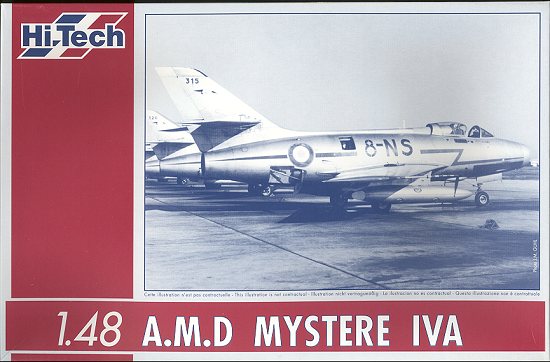
| KIT: | Hi-Tech 1/48 Dassault Mystere IVA |
| KIT # | 005 |
| PRICE: | $29.95 MSRP |
| DECALS: | One aircraft: EC 2/8 'Nice' |
| REVIEW & | |
| NOTES: | Multimedia kit |

| HISTORY |
The early 1950's were a time of transition in military aviation.Not only in the change from piston to turbojet powered aircraft, but the basicdesign of fast aircraft was changing as well. This is, of course, theintroduction of swept aerodynamic surfaces in order to forestall the effect of ahuge mass of air on the airframe called 'compressibility'. This effect is whatkept most straight-winged aircraft from entering the domain of transonic speeds.
Mostsuccessful aircraft of the period were, in effect, swept wing versions ofalready successful and tried aircraft. The F-86 derived from the straight wingedFJ-1, the F-84F from the F-84G, and, the Mystere IV from the Ouragan. The Frenchdesigner Marcel Bloch, who was a successful aircraft maker pre-war and whochanged his name from Bloch to Dassault, saw the trend and, being a cautious(and superstitious) man, waited until there was sufficient evidence that sweptwings were safe before redesigning the Ouragan.
As was tobe expected, the Mystere was just as reliable and successful as thepreceding Ouragan. It's first flight was in February of 1951, and based ontests, the French government ordered 17 development aircraft as Mystere II's.These were successful and based on this aircraft, a batch of 156 Mystere IIC'swere built. The major change was a more powerful Atar 101D engine and theinclusion of twin 30mm DEFA cannon. The aircraft was a major surprise to thoseoutside France who flew it. It was also quite fast, able to break Mach 1 in adive.
Even as the Mystere IIC was being built, the nextgeneration Mystere IV was well into its flight test program. Where the MystereIIC was basically a swept wing Ouragan, the Mystere IV was a completely newairframe. Despite looking quite similar to the Mystere IIC, there was not onestructural part that was interchangeable between the two. The IVA also had an'all flying' tailplane and a thinner wing. It was first flown in September 1952.A total of 421 were built between 1954 and 1958, 240 going to France, 110 toIndia and 60 to Israel.
Like all previous post war Frenchfighters, those going to France and Israel were fully funded by the US underwhat was known as Off Shore Procurement, a program designed to get thoseindustries that were destroyed in the war rebuilt and back under way.
MystereIVs were used in the Suez War of 1956 and had a very long and successful life.Even after being withdrawn from front-line service, they went on serve asadvanced training aircraft. EC 7 had a number of them on hand even aftertransitioning to Jaguars. EC 8 used them as fighter trainers, the last onesleaving service in the mid 1980s. Not bad for an aircraft that was then over 30years old. Today, there are a number of them extant as museum aircraft and atleast one is still airworthy and flown on occasion.
| THE KIT |
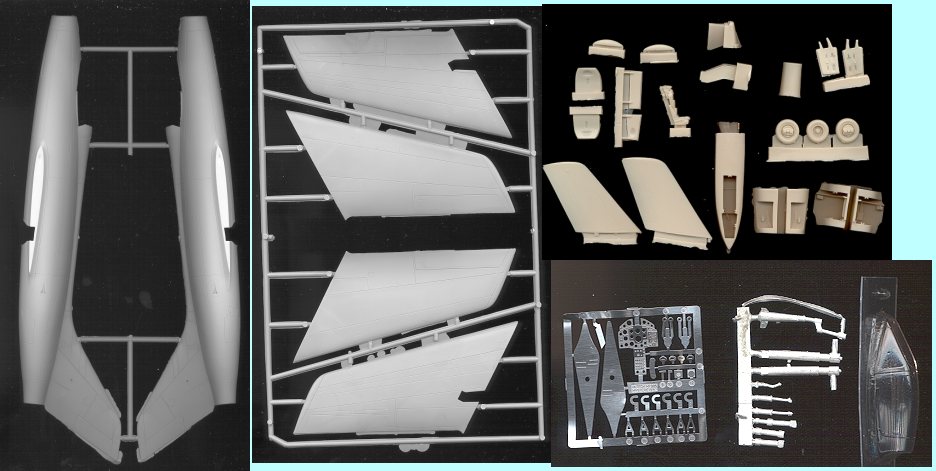
This kit is a true multimedia presentation. It has it all:injected styrene, resin, etched metal, cast metal and vacuform! The initialfeeling upon opening the box is one of getting your money's worth, especiallywhen looking at the big bag of resin parts! It is then time to take a closerlook as what is in the box itself.
After pulling out all the bits, one notices the injected parts.The detailing on them is very good. Nice and crisp without the rounded edgesgiven in a number of similar kits. This crispness carries over to the resinparts as well. One does also see that there is a bit of flash on the parts andthat it will be fun getting the intake properly rounded out.
Next I opened the bag containing the etched and cast metalparts. These parts are well done, though the cast metal bits will need somecleanup. These parts are basically the landing gear and the control column. Theetched parts did not fare too well being in the bag with those heavy cast partsand were rather well bent by all the jostling about on its trip from France viaTexas to here. These parts consist of oleo scissors, door hinges, instrumentpanel, rudder pedals, and tailplane plates as well as a few other bits.
The other bag contains a bunch of resin parts. Some of these arequite large and heavy and I was fearful of finding a lot of broken parts, butfortunately, only the cockpit antiglare shield suffered any damage. Parts donein resin consist of: nose section which contains the nose gear well, andcockpit. This part should be heavy enough to negate the need for nose weight asthere is really nowhere to put any! Getting back to the resin parts, there aremain gear wells and speedbrake wells, the gear doors themselves, speedbrakes,ejection seat, gun bulges, exhaust pipe, cockpit antiglare panel, tailplanes,and the wheels. Whew!! There is also a vacuform canopy. Again, just one. I dowish these folks would pop an extra in the kit for those of us who are a bitklutzy and may need a spare.
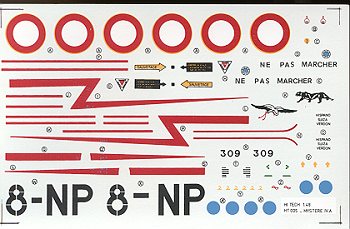 The decals arefor just one aircraft and are very complete. They are also VERY matte, offregister, and not as crisp as the typical aftermarket sheet. This is a shame asone is not likely to find any aftermarket sheets for this aircraft. The biggestproblem is finding new roundels as the thin yellow surround is badly offregister. I can only hope that I can find substitutes somewhere in my sparedecal boxes. It would have also been nice to have had an alternate scheme ortwo, but I do understand why not as it would have meant producing severaldifferent designs and colors of fuselage striping.
The decals arefor just one aircraft and are very complete. They are also VERY matte, offregister, and not as crisp as the typical aftermarket sheet. This is a shame asone is not likely to find any aftermarket sheets for this aircraft. The biggestproblem is finding new roundels as the thin yellow surround is badly offregister. I can only hope that I can find substitutes somewhere in my sparedecal boxes. It would have also been nice to have had an alternate scheme ortwo, but I do understand why not as it would have meant producing severaldifferent designs and colors of fuselage striping.
The instruction sheet is basically a sheet of paper folded inhalf making four pages. The opening page is a history in two languages. Itoffers a lot of info and insight into the version of the Mystere IVA that iskitted. The next two pages are two assembly steps. The last page is a decalplacement diagram and painting notes. The aircraft is overall aluminum with anumber of flat black areas, so those that don't like natural metal don't have toworry about this one.
Just to give you an idea of the various marking schemes that theMystere IVA carried, here are some photos taken from my personal archives. Allwere photographed in the 1970-1980 time frame. You can see from 8-MX the finalplacement of the codes prior to the retirement of the type in the 1980s. EC 8 was thelast unit to use them.
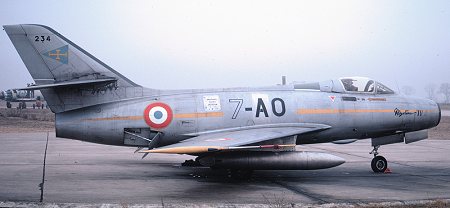
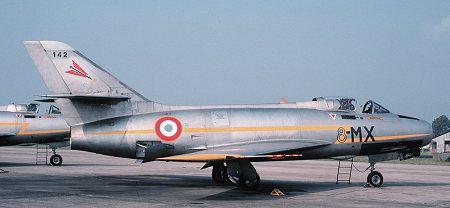
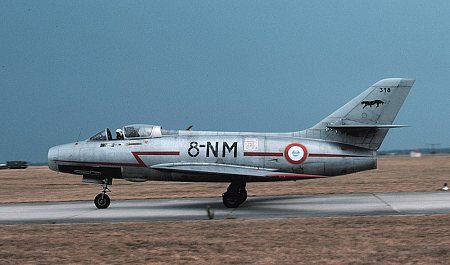
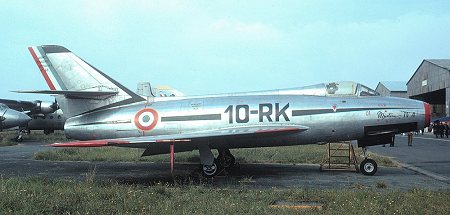
| REFERENCES |
Illustrated Encyclopedia of Aircraft #181, OrbisPublishing.
Review copy courtesy of SquadronMail Order
If you would like your product reviewed fairly and fairly quickly by asite that has over 900 visits a day, please contactme or see other details in the